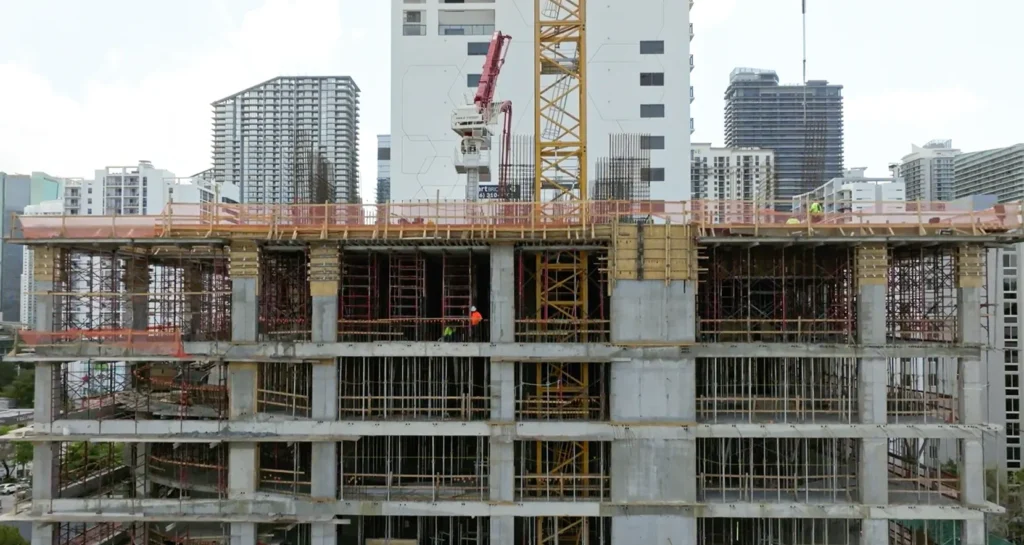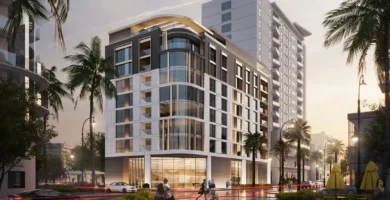
Real estate projects in the United States represent a wide range of opportunities for both developers and investors.
From skyscrapers that define the skyline of cities to residential complexes that offer a new definition of home, these projects are at the heart of growth and innovation in the real estate sector.
In a country where the real estate market is as diverse as its geography, understanding the different types of real estate projects and how they are financed is essential for those seeking to participate in this dynamic sector.
In addition, the U.S. real estate sector not only offers investment opportunities with significant return potential but also opens doors to international investors through programs such as EB-5, which links real estate investment with the possibility of obtaining permanent residency.
This program has become an attractive avenue for those seeking not only a financial return but also a pathway to life in the United States.
Let’s take a closer look at what real estate projects in the United States are like, the investment opportunities they offer, how these projects are financed, and finally how the EB-5 program can be a bridge for investors to obtain a Green Card.
Real estate projects in the United States
Real estate projects in the United States encompass the development, construction, and management of properties for a variety of uses, including residential, commercial, industrial, and mixed-use.
These projects are critical to economic growth, providing essential infrastructure, housing space, and business centers that facilitate daily life and commerce.
Types of Real Estate Projects
Residential
This division includes single-family homes, condominiums, apartments, and housing complexes. They are designed to offer comfortable and functional living spaces for individuals and families, with an emphasis on safety, accessibility, and amenities.
This type of project prioritizes privacy, comfort, and aesthetics, and usually includes green areas, sports facilities, and community spaces.
For example, Hudson Yards in New York is a project that offers a combination of luxury residences with breathtaking views and access to premium amenities.
Commercials
These include offices, stores, shopping malls, and hotels. These projects are focused on providing spaces for business and services, optimizing the customer experience and the operational efficiency of companies.
The commercial projects stand out for their strategic location, accessibility, and design oriented to maximize visibility and customer flow.
Within this category, we have the Mall of America in Minnesota, one of the largest malls in the country, which offers a wide range of shopping and entertainment.
Industrials
These projects include warehouses, factories, and industrial parks. They are designed to house production, warehousing, and distribution operations, and are essential to the supply chain and the economy.
It must be considered that, because of this, they require ample space, accessibility to transportation routes, and compliance with specific regulations for operations and safety.
The best example of this type of real estate project is the CenterPoint Intermodal Center industrial park in Illinois, which was established as a facilitator of large-scale logistics operations, connecting rail, road, and air transportation.
Mixed
Mixed-use real estate projects combine residential, commercial, and sometimes industrial elements in a single project. These developments seek to create integrated communities that offer a mix of housing, work, and entertainment, promoting a convenient and sustainable lifestyle.
They are characterized by their integral planning, seeking to harmonize the different uses to improve the quality of life of their occupants.
The Wharf in Washington D.C. is an example of a mixed-use development that combines housing, office, retail, and cultural spaces along the Potomac River.
These real estate projects not only reflect the diversity and dynamism of the U.S. market but also offer ample investment and development opportunities, contributing significantly to the economic and social fabric of the country.
Investment Potential
Investment potential in U.S. real estate projects varies depending on the type of project, location, and market conditions. Some key factors to consider include:
- Location: Properties in areas with high demand for housing or retail tend to offer better returns.
- Economic growth: Regions with growing economies present opportunities for property value appreciation and rental demand.
- Demographic trends: Changes in the population, such as the aging of the baby boomers or the preferences of millennials, may influence the demand for certain types of properties.
- Innovation and sustainability: Projects that incorporate advanced technology and sustainable practices can attract more environmentally conscious tenants and buyers, enhancing investment potential.
Investing in U.S. real estate projects offers a wide range of opportunities, each with its own risks and rewards. Careful evaluation of the market, location, and future trends is essential to maximize investment potential in this diverse and dynamic sector.
Investment Opportunities in Real Estate Projects
Real estate projects are considered a good investment option for several fundamental reasons:
Tangible Value and Stability
Unlike other investments, real estate offers a tangible asset that has intrinsic value.
Land and buildings are less likely to experience long-term depreciation compared to other volatile assets such as equities.
This tangibility and stability make real estate investment attractive to those seeking to reduce risk in their portfolio.
Appreciation Potential
Over time, real estate tends to increase in value. Appreciation can be driven by factors such as development in the surrounding area, improvements to the property, and changes in the real estate market.
This appreciation can result in a significant return on investment when the property is sold.
Rental Income
Real estate projects can generate a steady income through rental income.
This is an attractive way to obtain a regular cash flow, which can provide a stable return while maintaining the property as a long-term investment.
Tax Benefits
Real estate investment offers several tax benefits, including deductions for depreciation, mortgage interest, and operating expenses. These benefits can significantly improve the profitability of the investment.
Identification of Ideal Real Estate Projects
To identify real estate projects with high return potential, investors should consider several factors:
Location
Location is one of the most critical factors in the success of a real estate investment. Properties in areas with high demand, good infrastructure development, and access to services tend to appreciate more quickly.
Development Potential
Properties that offer opportunities for development or improvement can offer significant returns once the necessary investments are made.
Market Analysis
Understanding real estate market trends, including rental rates, demand for housing or commercial space, and economic forecasts, can help identify promising investment opportunities.
Financial Evaluation
Analyzing operating costs, potential rental income, and possible improvement expenses is crucial in determining the potential return on an investment.
Diversification
Portfolio diversification through real estate investing is achieved by investing in different types of properties and markets. This can include a mix of residential, commercial, and industrial properties, as well as investments in different geographic locations.
Diversification helps mitigate risk, as real estate performance can vary by property type and location, ensuring that a downturn in one segment can be offset by stability or gains in another.
In addition, combining real estate investments with other types of financial assets can provide a healthy balance between risk and return, improving the overall resilience of the investment portfolio.
Real Estate Project Finance
Real estate project financing is vital to carry out developments from residential to commercial. There are several avenues of financing available, each with its own characteristics and requirements:
Bank Loans
Bank loans are one of the most common sources of financing for real estate projects. Banks offer different types of loans tailored to the needs of the project, including construction loans and long-term mortgage loans.
Requirements for obtaining a bank loan usually include a solid business plan, collateral, and a favorable credit history.
Private Equity Investment
Private equity investment involves raising funds from individual investors or investment funds seeking a return on their investment through the success of the project. This option is particularly attractive for innovative or large-scale projects that can offer high returns.
In addition, as we will see below, through the EB5 program, foreign investors can invest and, in addition, gain access to U.S. citizenship for themselves and their families.
Real Estate Crowdfunding
Real estate crowdfunding has gained popularity as a way to finance projects through small investments made by a large number of people, usually through online platforms.
This way allows investors to participate in real estate projects with more accessible investment amounts.
The EB-5 Program: Investing where you want to live
The EB-5 program is a U.S. government initiative designed to encourage foreign investment in the United States by offering investors and their families the possibility of obtaining permanent residency, commonly known as a Green Card.
This program has become a key tool for financing real estate projects in the United States, opening doors to a wide range of opportunities for both investors and developers.
To participate in the EB-5 program, foreign investors must invest a minimum of $900,000 in projects located in Targeted Employment Areas or $1.8 million in other areas. In addition, these projects must generate at least 10 full-time jobs for each investment made.
Real estate projects, with their inherent ability to create jobs through construction, operation, and maintenance, align perfectly with the requirements of the EB-5 program, making real estate investment an attractive option for meeting these criteria.
Benefits of investing through the EB-5 program
Investing in real estate projects through the EB-5 program not only offers the possibility of a financial return but also provides investors with the opportunity to obtain permanent residency in the United States for themselves and their families.
This aspect makes the EB-5 program a doubly beneficial option, combining investment opportunities in the robust U.S. real estate market with significant immigration advantages.
Over the years, numerous real estate projects have been successfully financed through the EB-5 program, ranging from luxury condominiums and hotels to commercial complexes and residential developments.
These projects have not only contributed to the economic growth and beautification of their respective communities but have also generated thousands of jobs, fulfilling the core objectives of the EB-5 program.
The EB-5 program represents a unique synergy between foreign investment and real estate development in the United States, offering tangible benefits to both investors and local communities.
Through this program, investors have the opportunity to be an integral part of the growth and development of the U.S. real estate landscape, while working their way toward permanent U.S. residency, thus fulfilling their financial and personal goals.
A bridge between foreign investors and real estate projects
The EB-5 program stands out as a valuable bridge between foreign investors and the U.S. real estate market, offering the possibility to participate in significant projects that not only promise financial returns but also the opportunity to obtain permanent residency.
This program underscores the importance of foreign investment in stimulating economic growth and job creation while opening doors for individuals and families seeking to build a future in the United States.
Looking ahead, the U.S. real estate market continues to present a promising outlook, driven by innovation, sustainable development, and adaptation to new ways of living and working.
The role of the EB-5 program, along with other avenues of financing and investment, will continue to be crucial in the realization of real estate projects that not only enrich the urban landscape but also strengthen the economy and the community at large.
U.S. real estate projects are a testament to the strength and potential of the real estate sector, offering unprecedented opportunities for investors and professionals alike, with the EB-5 program playing an essential role in connecting global ambitions with U.S. realities.
Contact us for more information about the eb5 program.

